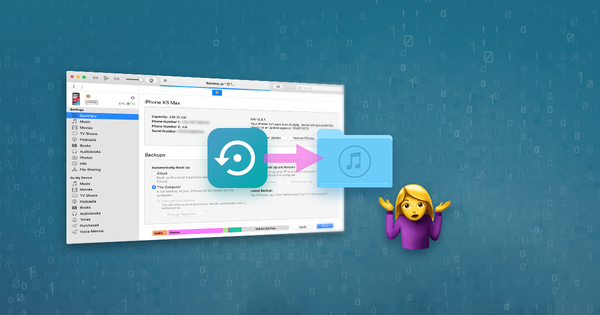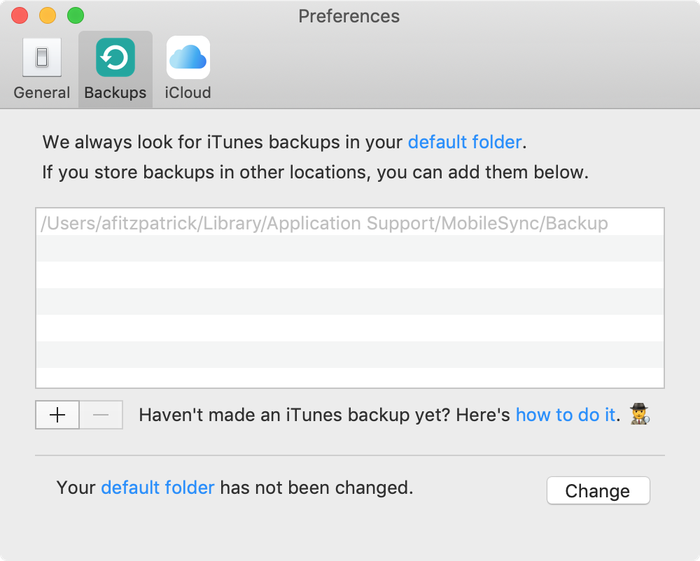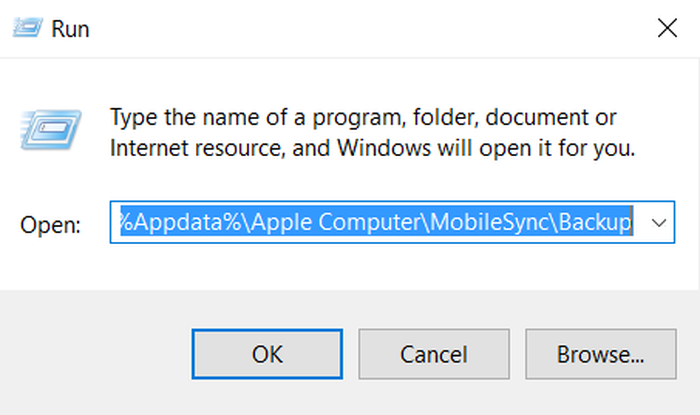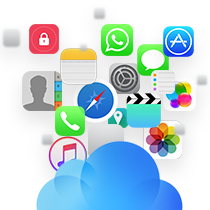Dove sono archiviati i backup iPad e iPhone su PC o Mac?

Se accidentalmente hai cancellato alcune informazioni da un dispositivo iOS e speri di recuperarlo, un backup di iTunes può essere di grande aiuto.
I backup di iTunes avvengono automaticamente, ogni volta che colleghi iPad o iPhone con iTunes (se non hai attivato l'opzione iCloud Backup), o manualmente, quando fai clic con il pulsante destro del mouse sul dispositivo in iTunes e scegli "Backup". Vengono salvati sul computer e contengono dati importanti, come contatti, messaggi di testo, calendario, note, cronologia chiamate e dati delle app.
Quindi dove sono archiviati i backup di iPhone o iPad? Dipende dal sistema operativo utilizzato dal computer, sebbene il percorso di backup predefinito sia lo stesso tra le versioni iOS.
Dov'è la cartella di backup di iTunes su Windows?
I backup di iTunes sono memorizzati in %APPDATA%\Apple Computer\MobileSync su Windows.
Su Windows 10, 8, 7 o Vista, questo sarà un percorso come \Users\[USERNAME]\AppData\Roaming\Apple Computer\MobileSync\Backup .
Con Windows XP sarebbe simile a \Documents and Settings\[USERNAME]\Application Data\Apple Computer\MobileSync\Backup .
La versione Microsoft Store di iTunes è un po 'diversa: memorizza i suoi backup sotto %HOMEPATH%\Apple\MobileSync . Quello sarà un percorso come \Users\[USERNAME]\Apple\MobileSync\Backup .
Dov'è la cartella di backup di iTunes su macOS / OS X?
I backup di iTunes sono memorizzati in ~/Library/Application Support/MobileSync su macOS.
Quella cartella è in genere in /Users/[USERNAME]/Library/Application Support/MobileSync/Backup .
In macOS 10.15, Finder crea backup di iPhone, anziché iTunes. Tuttavia, questi backup sono archiviati nella stessa posizione.
Come trovare automaticamente la cartella di backup di iTunes
iPhone Backup Extractor trova automaticamente la cartella di backup di iTunes e può aprirlo con un clic. Questa funzionalità è nella versione gratuita, quindi non costa nulla.
- Scarica e installa iPhone Backup Extractor
- Apri la finestra delle
Preferencesdal menu a discesa dell'app - Seleziona la scheda
Backups. - Dove la finestra dice "Cerchiamo sempre i backup nella cartella predefinita", fai clic sul link "cartella predefinita". Facile!

Apertura della cartella di backup di iTunes su Windows
Aprire il percorso di backup predefinito in Esplora risorse usando il comando Esegui di Windows. Premi ⊞ Win + R per visualizzare la finestra Esegui. Immettere %APPDATA%\Apple Computer\MobileSync e premere ⏎ Enter .
Per la versione Microsoft Store di iTunes, è possibile eseguire questa operazione: Premere ⊞ Win + R e dovrebbe apparire la finestra Esegui. Immettere %HOMEPATH%\Apple\MobileSync e premere ⏎ Enter .
Ecco come appare su Windows 10:

La finestra Esplora che verrà visualizzata mostrerà una cartella denominata "Backup". Questo contiene tutti i backup di iTunes che sono già presenti sul computer.
Trovare la cartella di backup di iTunes su macOS
La posizione di backup predefinita può essere visualizzata in Finder utilizzando Spotlight. Premendo ⌘ Cmd + e digita ~/Library/Application Support/MobileSync prima di premere ⏎ Enter .
La finestra del Finder che si apre mostrerà una cartella denominata "Backup". Questo contiene tutti i backup di iTunes che sono già presenti sul computer.
Modifica la posizione della cartella di backup di iTunes?
Se desideri cambiare la cartella su cui iTunes esegue il backup per impostazione predefinita, abbiamo una guida pratica nel nostro centro di supporto.


di Sohaib Ahmed
Thanks alot.
Cheers.. .. .!!!
di Jake Lown
Hi, I would like to restore a previous backup but I'm having trouble finding out my backup password. Can you please help me with this?
risposta di: Reincubate Support
Hey Jake, we've got a guide on password recovery. You can find it here.
di Gerry Wood
Many thanks for enabling me to find the backup file for my iphone on my PC. When I click on the properties of the backup file it shows that I have 2.23gb backed up in 3503 files which is reassuring.
If I now wish to view the contacts that have been backed up or restore them to a different device how do I do that if I've replaced my iphone with an android phone?
risposta di: Reincubate Support
Hi Gerry, thanks for asking. We're glad the article was helpful. If you install iPhone Backup Extractor, you'll see the free edition lets you browse through all of your contacts. Try that — it can export your contacts into a
VCFformat that your Android will easily be able to import.di Apple Repair New Orleans
I plan to buy an iPhone 6S Plus from a client, but they want me to transfer all their data to their old 5C. I backed it up in iTunes, then plugged in the 5C, but the 6s backup is nowhere to be seen from the drop down list!
The 5C is 32GB and the 6S Plus is only 16GB, so I don't know what the problem is. Any ideas?
risposta di: Reincubate Support
Hi guys, thanks for commenting. This one's an old chestnut: it's caused by one of the phones running a different version of iOS to the backup. Upgrade one or other so that they're running the same version, then update the backup. That'll sort it out!
di Justin
First of all; Thanks for the easy and helpful steps to get this far in the process. I am just curious as I am copying my backup off of my pc if it just as simple as me copying this backup off of my (non internet accessible) pc onto a hard drive, then I can drag and drop into the list of backups on the new Mac. I am trying to restore my old backup onto my new iPhone six, but my pc has lost ability to connect to the Internet, so I can't download the new iTunes update to be able to work with my iPhone six.
risposta di: Reincubate Support
Justin! Thanks for writing. Yes, it really is that easy. You can move iTunes backup folders between Macs, or even between Macs and PCs.
di Brian Corbett
You have confirmed to me the preposterous nature of the iPad backup system. Why can't they use files like windows?
risposta di: Reincubate Support
Hi Brian, the iOS device does all the work when making a backup and simply relays the data to the PC or Mac (or to iCloud). They use this format partly to make it straightforward (and fast!) for the device, but also to discourage inadvertent modification of files, and to easily be able to layer encryption on top. It works pretty well in most cases!
di Chris
i found the backup files but they look coded in jibberish. how can i read them as they would appear from my phone, opposed to being random numbers and letters? please halp
risposta di: Reincubate Support
Hi Chris, that's what iPhone Backup Extractor does. Load up the free version, and choose "Expert mode". That'll show you the structure the files decode to. 👍
di Bennie
My iphone and ipad was backed on the same computer, will it be a separate folder or combine on the same folder?
risposta di: Reincubate Support
Hi Bennie, they'll be in separate folders, both in the master
Backupsfolder. Each folder will be named after the phone's UDID, which is a long phrase name of letters and numbers.di Mosin
How do i get the contacts from the folder on to a android? could you please let me know as soon as possible please
risposta di: Reincubate Support
Hi Mosin, thanks for commenting! We've got a guide that takes you through transferring contacts to Android here.
di sf
would u also tell me how do i get there..
i mean where i can find Users\USERNAME\AppData\Roaming\Apple Computer\MobileSync\Backup
as i am using windows 7
risposta di: Reincubate Support
Hi sf: sure! We've updated the article to make it clearer that Windows backups are stored under a different location. Does that help?